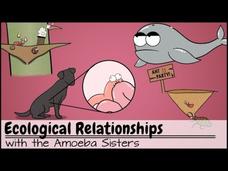Scholastic
Study Jams: Symbiosis
Three types of symbiosis are explained: parasitism, commensalism, and mutualism. This is done with colorful animation and lively dialogue in a straightforward and easy-to-follow manner. Have your ecology class watch this at home and then...
Teacher's Pet
Species Interactions
Every species competes for food. The video explains interspecific competition, intraspecific competition, and the competitive exclusion principle as a part of predator-prey relationships. It also covers resource partitioning and the...
Bozeman Science
Populations
The largest concentration of free-roaming wildlife in the continental United States is found in Yellowstone National Park. A video describes the three main types of population interactions: mutualism, commensalism, and parasitism. It...
Curated OER
Populations
Every species in the world has some type of relationship with another species, whether it be positive, negative, or neutral for each party. Mr. Andersen defines each type of relationship and provides clear examples under each category....
TED-Ed
You and Your Microbes
Humans are like planets, hosting a plethora of microbial communities. This concept is explored with vivid narration and animation, bringing to light the benefits of the huge variety of microbes that live in and on our bodies. What a fun...
Amoeba Sisters
Ecological Relationships
What are ecological relationships? Well, it can be complicated! Paint a clear picture for pupils with a fun and informative video. It explains and illustrates each relationship thoroughly, from pesky parasites to snuggly symbiotes.







